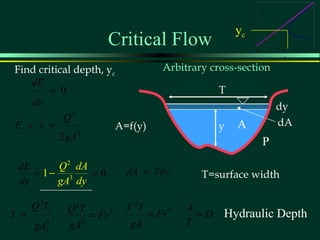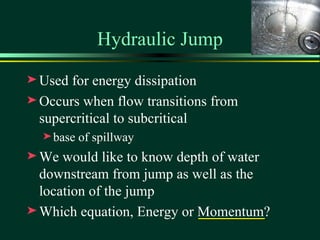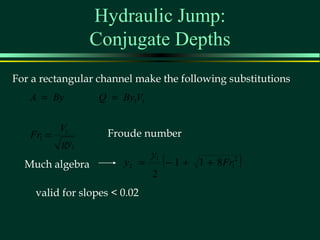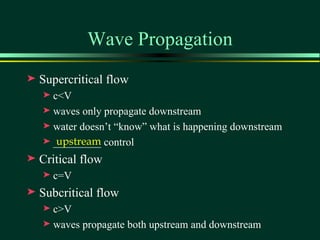Open channel flow refers to liquid flow with a free surface, such as in rivers, streams, canals, and culverts. It is relevant for both natural and engineered channels. Some key topics in open channel flow include uniform flow, channel transitions, critical flow, hydraulic jumps, and gradually varied flow. The flow can be classified based on whether it is steady or unsteady, uniform or nonuniform, and laminar or turbulent. Analyzing open channel flow involves the conservation of energy and momentum equations. The Manning equation and other relationships are commonly used to relate variables like flow depth, velocity, discharge, and channel properties. Critical flow occurs when the specific energy is minimized.














![1
Trapezoidal Channel Q = ARh / 3 S o / 2
2 1
n
® Derive P = f(y) and A = f(y) for a
trapezoidal channel
® How would you obtain y = f(Q)?
A = yb + y 2 z
1 y
z
[
P = 2 y 2 + ( yz ) ]
2 1/ 2
+b b
[
P = 2 y 1+ z ]
2 1/ 2
+b
Use Solver!](https://image.slidesharecdn.com/hidro-120415054726-phpapp01/85/Hidro-15-320.jpg)




















![Gradually Varied Flow
d V 2
= d Q2
− 2Q 2 dA
= ⋅
− Q 2T
= = − Fr 2
dy 2 g
dy 2 gA2
2 gA3 dy
gA3
Change in KE
dy d V 2 dx dx
+ +Sf = So Change in PE
dy dy 2 g
dy dy
We are holding Q constant!
dx dx
1 − Fr + S f
2
= So
dy dy
dy dy So − S f
[1 − Fr ]
2
= So − S f =
dx dx 1 − Fr 2](https://image.slidesharecdn.com/hidro-120415054726-phpapp01/85/Hidro-36-320.jpg)










![Wave Celerity
Vw
y y+δy y
V V+δV V-Vw V+δV-Vw y+δy
unsteady flow steady flow
1 1
F1 = ρgy 2
F2 = ρg ( y + δy ) 2
2 2 F1 F2
Fr = F1 − F2 =
1
[
ρg y − ( y + δy )
2 2
] V-Vw V+δV-Vw
2](https://image.slidesharecdn.com/hidro-120415054726-phpapp01/85/Hidro-47-320.jpg)
![Wave Celerity:
Momentum Conservation
Fr = M 2 − M 1 M 1 = − ρ (V − Vw ) y
2
Per unit width
Fr = ρy ( V − Vw ) [ ( V + δV − Vw ) − ( V − Vw ) ]
Fr = ρy ( V − Vw ) δV
y V-Vw V+δV-Vw y+δy
1
[ ]
ρg y 2 − ( y + δy ) 2 = ρy ( V − Vw ) δV
2
1 steady flow
g [ − 2 yδy ] = y ( V − Vw ) δV
2
− gδy = ( V − Vw ) δV](https://image.slidesharecdn.com/hidro-120415054726-phpapp01/85/Hidro-48-320.jpg)













